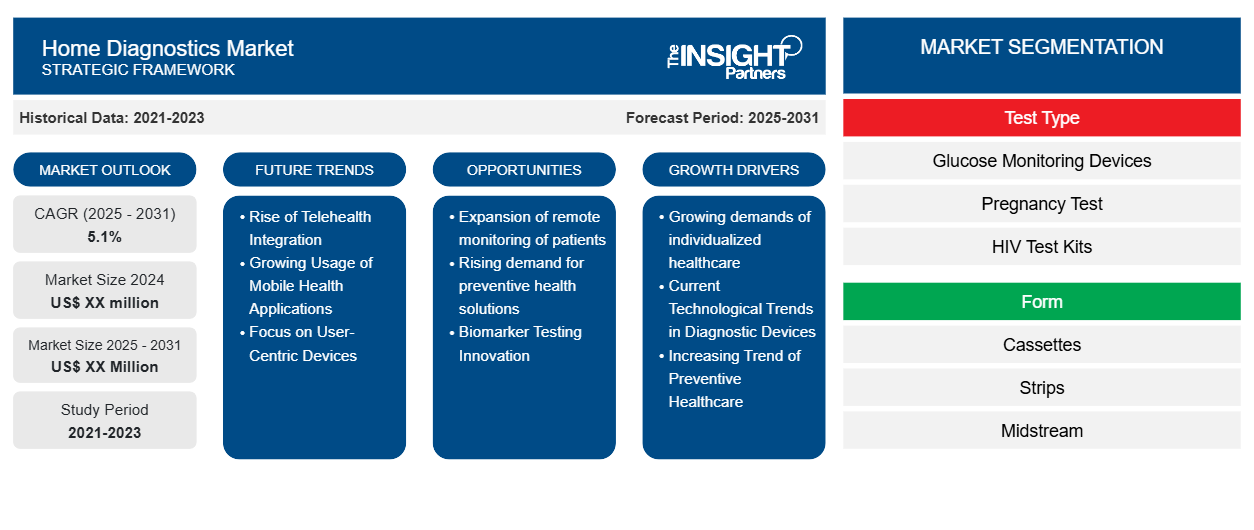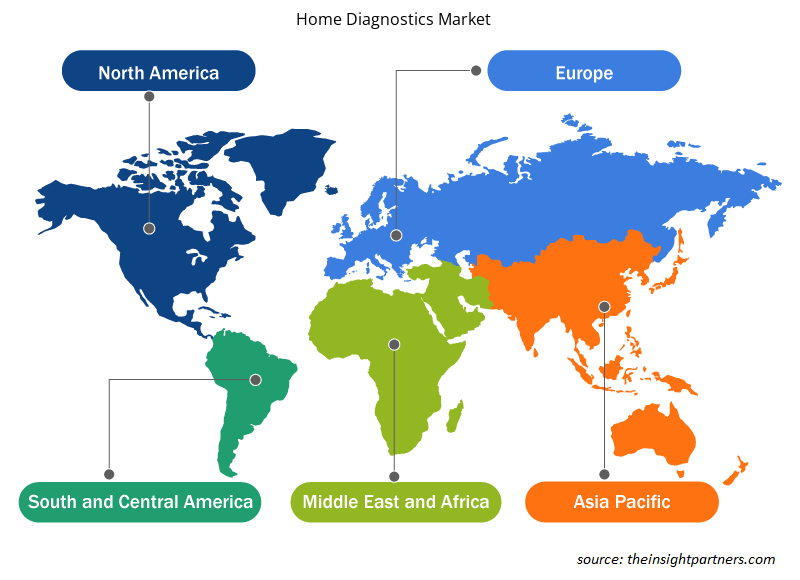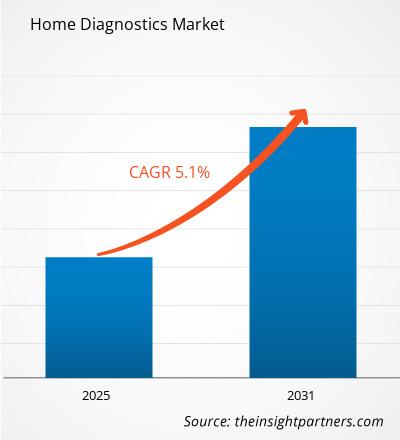Si prevede che il mercato della diagnostica domestica registrerà un CAGR del 5,1% dal 2025 al 2031, con una dimensione di mercato in espansione da XX milioni di dollari nel 2024 a XX milioni di dollari entro il 2031.
Il rapporto è suddiviso in base al tipo di test (dispositivi di monitoraggio del glucosio, test di gravidanza, kit per test HIV, kit per test di rilevamento del colesterolo, kit per test di abuso di droghe, altri); forma (cassette, strisce, midstream, strumenti di monitoraggio digitale, pannello di test, schede di immersione); tipo di campione (sangue, urina, saliva, altri); canale di distribuzione (farmacie al dettaglio, farmacie, ipermercati/supermercati, farmacie online). L'analisi globale è ulteriormente suddivisa a livello regionale e nei principali paesi. Il rapporto offre il valore in USD per l'analisi e i segmenti di cui sopra.
Scopo del rapporto
Il report Home Diagnostics Market di The Insight Partners mira a descrivere il panorama attuale e la crescita futura, i principali fattori trainanti, le sfide e le opportunità. Ciò fornirà spunti a vari stakeholder aziendali, come:
- Fornitori/produttori di tecnologia: per comprendere le dinamiche di mercato in evoluzione e conoscere le potenziali opportunità di crescita, consentendo loro di prendere decisioni strategiche informate.
- Investitori: condurre un'analisi completa delle tendenze relative al tasso di crescita del mercato, alle proiezioni finanziarie del mercato e alle opportunità esistenti lungo la catena del valore.
- Enti di regolamentazione: regolamentano le politiche e le attività di controllo sul mercato allo scopo di ridurre al minimo gli abusi, preservare la fiducia degli investitori e sostenere l'integrità e la stabilità del mercato.
Segmentazione del mercato della diagnostica domestica
Tipo di prova
- Dispositivi di monitoraggio del glucosio
- Test di gravidanza
- Kit per il test dell'HIV
- Kit di test per la rilevazione del colesterolo
- Kit per test di abuso di droghe
- Altri
Modulo
- Cassette
- Strisce
- A metà strada
- Strumenti di monitoraggio digitale
- Pannello di test
- Carte da immersione
Tipo di campione
- Sangue
- Urina
- Saliva
- Altri
Canale di distribuzione
- Farmacie al dettaglio
- Farmacie
- Ipermercati / Supermercati
- Farmacie online
Personalizza questo report in base alle tue esigenze
Riceverai la personalizzazione gratuita di qualsiasi report, comprese parti di questo report, o analisi a livello nazionale, pacchetto dati Excel, oltre a usufruire di grandi offerte e sconti per start-up e università
Mercato della diagnostica domestica: approfondimenti strategici

-
Scopri le principali tendenze di mercato in questo rapporto.Questo campione GRATUITO includerà analisi di dati che spaziano dalle tendenze di mercato alle stime e alle previsioni.
Fattori di crescita del mercato della diagnostica domestica
- Crescenti richieste di assistenza sanitaria personalizzata: il principale fattore chiave nel mercato della diagnostica domiciliare è la domanda di assistenza sanitaria personalizzata. Le crescenti esigenze implicano che le persone richiedano un approccio più proattivo al monitoraggio della salute e trattamenti personalizzati in base alle esigenze individuali. Gli utenti possono effettuare test convenienti a casa, che forniscono risultati che offrono un output immediato verso decisioni sanitarie più prudenti, che portano a un maggiore coinvolgimento del paziente con l'aderenza a un piano.
- Tendenze tecnologiche attuali nei dispositivi diagnostici: i progressi nella tecnologia dei dispositivi diagnostici danno un'enorme spinta al mercato della diagnostica domestica. La disponibilità di kit di test, smartphone e funzionalità di telemedicina rende la diagnostica domestica facile da usare e accessibile al consumatore. Tali progressi non solo rendono i test a domicilio più accurati e affidabili, ma aumentano anche la fiducia dei consumatori, facendo sì che più persone adottino tali soluzioni per il monitoraggio e la gestione della salute.
- Tendenza crescente dell'assistenza sanitaria preventiva: l'assistenza preventiva sta guidando il mercato della diagnostica domiciliare. Ciò significa che le persone ora si stanno concentrando sulla diagnosi precoce e sulla gestione delle condizioni di salute. Gli strumenti di diagnostica domiciliare monitorano frequentemente gli indicatori vitali della salute per determinare quando potrebbero svilupparsi potenziali problemi di salute prima che peggiorino. Tale approccio incoraggia stili di vita sani e riduce il costo totale dell'assistenza sanitaria sia per gli individui che per i sistemi, risultando quindi in linea con la salute pubblica.
Tendenze future del mercato della diagnostica domestica
- Ascesa dell'integrazione della telemedicina: l'integrazione della telemedicina è stata la caratteristica dominante del mercato della diagnostica domiciliare. Anche le apparecchiature diagnostiche stanno prendendo forma, con strutture di integrazione con i servizi di telemedicina, poiché l'assistenza sanitaria virtuale sta aumentando. Ciò può aiutare nell'analisi remota da parte del professionista sanitario e nella consulenza in tempo reale per il paziente, fornendo al contempo un'assistenza efficace ai pazienti. L'accessibilità e la praticità sono aumentate e, durante le emergenze, l'intervento medico è tempestivo.
- Utilizzo crescente di applicazioni sanitarie mobili: le applicazioni sanitarie mobili stanno cambiando l'ambiente di Home Diagnostics. Queste app aiutano a tracciare i dati sanitari di un utente, leggere i risultati dei test e ottenere informazioni sulla salute dagli esperti. La richiesta di un maggiore controllo sulla propria salute è stato un fattore che collega la diagnostica alla tecnologia mobile, aumentando ulteriormente l'interazione dell'utente, facilitando l'aderenza a un regime di salute e aiutando con un processo decisionale informato.
- Concentrarsi sui dispositivi incentrati sull'utente: c'è una crescente domanda di sviluppare dispositivi diagnostici intuitivi rivolti ai non professionisti. Con la crescente tendenza di prodotti facili da usare e intuitivi che richiedono poca formazione, ciò garantirà che le persone possano condurre i loro test con precisione dalle loro case. Aumentare la fiducia e la soddisfazione degli utenti rende la tendenza più attraente e raggiungibile per una popolazione più ampia che non possiede competenze tecniche.
Opportunità di mercato per la diagnostica domestica
- Espansione del monitoraggio remoto dei pazienti: la diagnostica domiciliare è una delle opportunità più significative che il mercato offre oggi, poiché l'estensione del monitoraggio remoto dei pazienti si espande e consente all'assistenza sanitaria di progredire attraverso il monitoraggio remoto e la tecnologia che consente ai dispositivi diagnostici domiciliari all'interno di questi sistemi di monitorare l'assistenza sanitaria e intervenire immediatamente quando necessario, consentendo così una migliore assistenza ai pazienti senza aumentare le visite in ospedale da parte dei fornitori, offrendo quindi sia ai pazienti che ai fornitori l'opportunità di trarne vantaggio.
- Domanda crescente di soluzioni di salute preventiva: con il crescente interesse per le soluzioni di salute preventiva, Home Diagnostics può cogliere queste opportunità. I consumatori stanno diventando attenti alla salute e vogliono essere proattivi nel monitorare la propria salute. Un'azienda può capitalizzare tale domanda offrendo strumenti diagnostici a prezzi accessibili e accessibili, aiutando così le persone a identificare potenziali problemi di salute in una fase precoce e a gestire efficacemente il proprio benessere, contribuendo quindi alla crescita del mercato.
- Innovazione nei test sui biomarcatori: ci sono molte interessanti opportunità di sviluppo nel mercato della diagnostica domiciliare. I test sui biomarcatori avanzati, attraverso la loro ricerca in continua evoluzione, sviluppano anche più scoperte di biomarcatori di altre malattie, fornendo così nuove diagnosi da testare a casa di un paziente e preziose conoscenze sulle condizioni di salute. Le aziende che impiegano tempo e risorse per ideare soluzioni di test così innovative e sofisticate possono attrarre clienti verso i loro prodotti poiché sempre più clienti desiderano un monitoraggio avanzato e la prevenzione dei loro problemi di salute.
Approfondimenti regionali sul mercato della diagnostica domestica
Le tendenze regionali e i fattori che influenzano il mercato della diagnostica domestica durante il periodo di previsione sono stati ampiamente spiegati dagli analisti di Insight Partners. Questa sezione discute anche i segmenti e la geografia del mercato della diagnostica domestica in Nord America, Europa, Asia Pacifico, Medio Oriente e Africa e America meridionale e centrale.

- Ottieni i dati specifici regionali per il mercato della diagnostica domestica
Ambito del rapporto di mercato sulla diagnostica domestica
| Attributo del report | Dettagli |
|---|---|
| Dimensioni del mercato nel 2024 | XX milioni di dollari USA |
| Dimensioni del mercato entro il 2031 | XX milioni di dollari USA |
| CAGR globale (2025 - 2031) | 5,1% |
| Dati storici | 2021-2023 |
| Periodo di previsione | 2025-2031 |
| Segmenti coperti |
Per tipo di test
|
| Regioni e Paesi coperti |
America del Nord
|
| Leader di mercato e profili aziendali chiave |
|
Home Diagnostica Market Players Densità: comprendere il suo impatto sulle dinamiche aziendali
Il mercato della diagnostica domestica sta crescendo rapidamente, spinto dalla crescente domanda degli utenti finali dovuta a fattori quali l'evoluzione delle preferenze dei consumatori, i progressi tecnologici e una maggiore consapevolezza dei vantaggi del prodotto. Con l'aumento della domanda, le aziende stanno ampliando le loro offerte, innovando per soddisfare le esigenze dei consumatori e capitalizzando sulle tendenze emergenti, il che alimenta ulteriormente la crescita del mercato.
La densità degli operatori di mercato si riferisce alla distribuzione di aziende o società che operano in un particolare mercato o settore. Indica quanti concorrenti (operatori di mercato) sono presenti in un dato spazio di mercato in relazione alle sue dimensioni o al valore di mercato totale.
Le principali aziende che operano nel mercato della diagnostica domestica sono:
- Becton Dickinson e la società
- Laboratori Abbott
- Società a responsabilità limitata
- ACON Laboratories Inc.
- Società Bionime
Disclaimer : le aziende elencate sopra non sono classificate secondo un ordine particolare.

- Ottieni una panoramica dei principali attori del mercato della diagnostica domestica
Punti di forza chiave
- Copertura completa: il rapporto esamina in modo completo i prodotti, i servizi, le tipologie e gli utenti finali del mercato della diagnostica domestica, offrendo una panoramica olistica.
- Analisi degli esperti: il rapporto è compilato sulla base della conoscenza approfondita di esperti e analisti del settore.
- Informazioni aggiornate: il rapporto garantisce la pertinenza aziendale grazie alla copertura di informazioni recenti e tendenze nei dati.
- Opzioni di personalizzazione: questo report può essere personalizzato per soddisfare le esigenze specifiche del cliente e adattarsi in modo appropriato alle strategie aziendali.
Il rapporto di ricerca sul mercato della diagnostica domestica può, quindi, aiutare a guidare il percorso di decodifica e comprensione dello scenario del settore e delle prospettive di crescita. Sebbene possano esserci alcune preoccupazioni valide, i vantaggi complessivi di questo rapporto tendono a superare gli svantaggi.
- Analisi storica (2 anni), anno base, previsione (7 anni) con CAGR
- Analisi PEST e SWOT
- Valore/volume delle dimensioni del mercato - Globale, Regionale, Nazionale
- Industria e panorama competitivo
- Set di dati Excel
Report recenti
Testimonianze
Motivo dell'acquisto
- Processo decisionale informato
- Comprensione delle dinamiche di mercato
- Analisi competitiva
- Analisi dei clienti
- Previsioni di mercato
- Mitigazione del rischio
- Pianificazione strategica
- Giustificazione degli investimenti
- Identificazione dei mercati emergenti
- Miglioramento delle strategie di marketing
- Aumento dell'efficienza operativa
- Allineamento alle tendenze normative






















 Ottieni un campione gratuito per - Mercato della diagnostica domestica
Ottieni un campione gratuito per - Mercato della diagnostica domestica